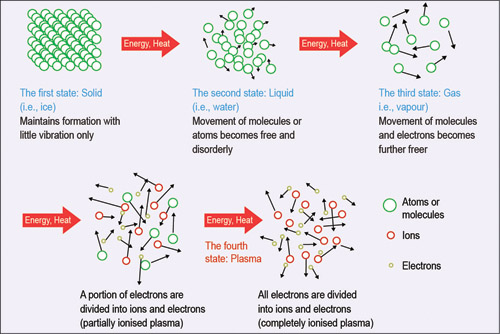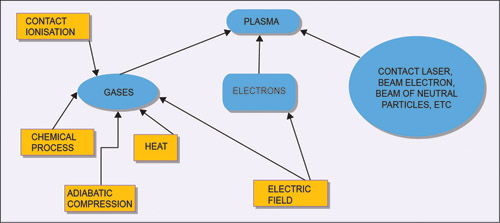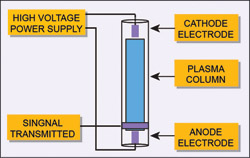Conceptually, the idea of plasma antenna is older than the transistor. In the early part of 20th century, due to extensive research in nuclear science from which the idea of plasma originated, it was theoretically estimated that the plasma medium can be exploited to make antennae having better capabilities and properties than metal antennae. Following this, the first patent for such an antenna was issued to J. Hettinger in 1919.
But now the question arises why the term ‘plasma antenna’ triggers a sense of unfamiliarity amongst us. The answer to this question is that although the concept of plasma antenna emerged very early but, due to non-availability of proper technology, this concept was practically realised only after 1995. And at that time also plasma antenna models were built around big and heavy discharge tubes that limited their flexibility.

It was in the year 2000 when a new branch in this field emerged in which this concept was realised utilising solid-state semiconductors. Although this concept is not mature enough, a lot of research has taken place and is still going on. Moreover, the California Institute of Technology has been successful in realising and applying this concept to create compact and dynamically-configured antennae.
In the case of metal antennae, taking a rough estimate, they can be used up to 4GHz of frequency range; beyond that, we need to make use of some hybrid or microstrip antennae. Now, as per the latest research, plasma antennae can be configured to operate up to 20GHz, which is far better than the range possible with traditional metal antennae.
Talking about research, most of the researches carried on this subject are by defence organisations. Commercial organisations are also contributing to this but their limited resources has been an issue.
Besides, since solid-state semiconductor realisation is very limited, discharge tubes are used for prototyping. The discharge tubes have their own disadvantages that limit their practical usefulness in commercial applications.
Understanding the plasma
Now, before talking of a plasma antenna, we should understand the term ‘plasma.’ There are five states of matter known to this date, namely, solid, liquid, gas, plasma and supercooled solid as shown in Fig. 1. Plasma is the fourth state of matter. The story of plasma starts with gases. A substance is said to be a gas if its boiling point is below room temperature under atmospheric pressure. More specifically, the intermolecular forces of attraction existing amongst the molecules are almost negligible. So that means higher the boiling point, higher the intermolecular forces of attraction.


Talking of electrical property of gases, we can say they are generally insulators. Now what happens when we supply thermal energy to the gases is that the heat absorbed is used to cut off the intermolecular forces. By applying more heat energy to the gases, we can convert them into a plasma state. Overall, this process is known as ionisation, i.e., the conversion of atoms to ions and electrons. For plasma to exist, ionisation is necessary. The term plasma density is a synonym to electron density.
Definition. Plasma can be defined as a set of quasi-neutral particles with free electric charge carriers which behave collectively. In this definition, two terms are very important:
(i) quasi-neutral. Meaning that there is the same quantity of positive and negative particles so, as a whole, it behaves as a fluid without net charge.
(ii) collectively. Meaning that plasma as a whole is capable of carrying out processes that generate electric and magnetic fields to which it can react. This is one of the most important properties that lead to some unparallel characteristics.
So basically, plasma is produced “when enough atoms are ionised to significantly affect the electrical properties of a gas under normal conditions.” It is not any alien form but only a state of ionisation, a state of matter. There are eleven elements that exist as gas under normal conditions. Out of these, group 18 elements are of prime importance (if we are analysing discharge tubes) as they are inert. Plasma is much visible matter in the universe, being about 99 per cent of all the matter. Besides astronomical plasma, we can distinguish two main groups of plasma from laboratory point of view:
(i) Thermal plasma. Here electrons and ions are at thermal equilibrium. But for this thermal equilibrium to exist, very high temperatures are required, specifically in the range of 4000K-20,000K. But this equilibrium makes this kind of plasma to be unfit for the antenna system application (welding, plasma torches, sintering and etching).











Thank you very much…. your article is so easy to understand and explained in a simple … i am happy bcoz now i am familiar with plasma antenna… you are a good author…. thank you again
You are most welcome.
excelente. aprendi mucho con su articulo
Gracias por tus comentarios.